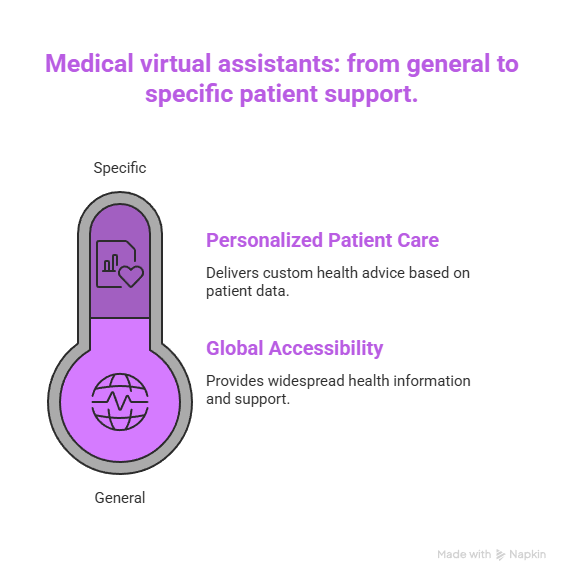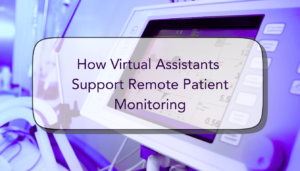The Rise of Global Medical Virtual Assistants: Transforming Healthcare Worldwide
10 Jun 2025 By: Vlade Legaspi
Updated

In recent years, tech changes have reshaped healthcare. One key shift is the rise of medical virtual assistants. These tips improve care by boosting speed, access, and focus on patients. This article covers their growth, perks, hurdles, and what lies ahead.
Understanding the Role of Global Virtual Assistants in Healthcare
Medical virtual assistants use AI to help doctors with daily tasks. They handle questions, book visits, remind patients about meds, and aid in telehealth calls—functions that define the value of virtual medical assistant services. By taking over simple duties, they let doctors spend more time on key patient needs.
What is The Technology Behind Global Medical Virtual Assistants in Healthcare?
Medical virtual assistants run on AI and machine learning. These tools help them learn from chats and get smarter. NLP lets them talk with patients in a natural way.
- NLP example: Understands “I feel dizzy” and replies, “Let me connect you to a doctor now.”
- AI example: Learns from past questions to give quicker, better answers.
- Machine learning example: Adapts advice based on a patient’s habits.
Also, linking with EHR systems boosts what they can do. It lets virtual assistants pull patient info safely to give tailored tips and answers. Patients then get fast, helpful advice that improves their care. Since they process huge data sets quickly, these tools can spot trends early and warn doctors of risks before they grow.
What are the different Types of Medical Virtual Assistants?
Medical virtual assistants come in many forms, each built for a role in healthcare. Some handle admin work like booking or billing, while others help with care tasks.
- Clinical example: Checks symptoms and reminds patients to take meds
- Admin example: Schedules patient visits and answers insurance questions..
Some virtual assistants are made for certain healthcare settings like hospitals, clinics, or telehealth assistant services. This helps them meet the unique needs of each care team and patient group. For example, in hospitals, they handle complex records and help coordinate care among specialists. In clinics, they focus on check-up reminders and preventive tips. This flexible setup boosts how smoothly things run. It also creates a personal feel, since assistants can match the provider’s goals and style.
Benefits of Medical Virtual Assistants

Adding medical virtual assistants to healthcare brings many benefits for both doctors and patients. These gains are fueling their fast growth worldwide.
Enhanced Efficiency
A key benefit of medical virtual assistants is better efficiency. They cut admin work and smooth out tasks, letting staff spend more time on patient care.
- Example: Reminders free nurses from routine follow-up calls.
- Example: Auto-scheduling saves front desk time for urgent tasks.
- Example: Billing bots reduce errors and speed up claims.
For example, virtual assistants can book appointments, letting receptionists focus on face-to-face care. This cuts wait times and boosts patient happiness. They also send follow-ups and reminders, helping patients stay on track with visits and care plans. This smart setup leads to better health results and a more efficient practice.
How to Improved Patient Engagement?
Medical virtual assistants help patients stay involved in their care. They give quick info and make it easy to ask questions or get reminders.
- Example: Shares tips on managing health between visits.
- Example: Answers, “When should I take this pill?” right away.
- Example: Sends alerts for check-ups, so patients don’t forget.
Virtual assistants work 24/7, so patients get help anytime, anywhere. This helps people with chronic issues or those in remote places with few health options. They also share custom health info, like treatment choices or lifestyle tips. This boosts patient confidence and sparks better talks with doctors, leading to smarter health decisions.
Challenges in Implementing Medical Virtual Assistants

Though helpful, using medical virtual assistants comes with challenges. Knowing these issues is key for healthcare groups planning to use this tech well.
What is Data Privacy and Security Concerns?
A top concern with medical virtual assistants is keeping data safe. Health info is private, and leaks can harm both patients and providers. Following rules like HIPAA is a must.
- Example: HIPAA rules help protect info during chats or file use.
- Example: A breach may expose patient records to hackers.
- Example: Assistants must use secure channels to share data.
Healthcare groups must use strong security to guard patient data with virtual assistants. This means using encryption, safe logins, and regular checks for weak spots. Teaching staff good data habits and staying alert helps prevent leaks. Adding multi-factor logins boosts safety, making sure only approved users reach private records.
Integration with Existing Systems
Another key challenge is connecting medical virtual assistants with current healthcare systems. Many providers use different software, making smooth links tough to set up. If systems don’t work well together, the virtual assistant may not run as planned, lowering its value.
To fix this, healthcare teams should plan and test before going live. Working with tech partners ensures systems match and run smoothly. Support and updates keep tools working as tech changes. Getting feedback from users during setup helps shape the assistant to better fit staff and patient needs.
The Future of Medical Virtual Assistants

The future of medical virtual assistants looks bright as AI and machine learning grow. These tools will soon offer smarter features and better ways to help patients.
Personalized Patient Care
A key part of the future for medical virtual assistants is personalized care. By studying patient data, they can give custom tips and answers based on each person’s needs.
- Example: Offers care tips linked to past symptoms or treatments.
- Example: Suggests diet changes based on patient health records.
- Example: Sends reminders timed to a patient’s daily habits.
This kind of personalized care can improve health results by giving advice that fits each patient’s needs and choices. A virtual assistant may suggest meal plans based on a person’s past health and habits, supporting full-body wellness. With wearable tech, they can track live health data like heart rate or blood sugar. This helps them adjust tips in real time, so patients always get the best and most current advice.
Global Accessibility
Medical virtual assistants can close care gaps in underserved areas. They give people in remote or poor regions access to health info and support.
- Example: Answers health questions where clinics are far away.
- Example: Guides a rural patient on treating cold symptoms.
- Example: Shares care tips in places with few doctors.
Telehealth and virtual assistants work together to connect patients and doctors across any distance. This broad access can greatly improve care for those with limited options. These assistants can also use many languages, helping more people get clear, useful health info. This support for different cultures improves patient understanding. It also builds a fairer healthcare system where everyone gets the care they need.
Case Studies: Successful Implementations
Many healthcare groups have added medical virtual assistants to their systems, showing how powerful this tech can be. These real cases offer useful tips and results.
Case Study 1: A Large Hospital System
A major U.S. hospital used a medical virtual assistant to improve scheduling and handle patient questions. It linked with their EHR system, giving it secure access to patient info.
This led to a 30% drop in scheduling time and fewer missed visits. Patients found it easier to book appointments and liked getting reminders, which raised overall satisfaction.
Case Study 2: A Telehealth Platform
A European telehealth platform launched a virtual assistant to help with triage and symptom checks. It asked patients key questions to assess symptoms and suggest next steps, like booking a virtual visit.
This boosted patient engagement by 40% and made triage faster. Patients felt more confident about getting care and received quicker help, which improved health results.
Frequently Asked Questions
TRENDING NOW
Global Medical virtual assistants may be powered by AI, but what they bring to people is warmth, comfort, and care. They’re the quiet, steady presence that helps you remember your appointment, explains your medication, or answers your question at midnight, no judgment, no waiting.
They support busy parents who are managing their family’s care, seniors who just need a little help staying on track, and anyone who’s ever felt lost in the healthcare system. They create space for real moments between doctors and patients by handling the noise, scheduling, reminders, paperwork, so people can focus on people.
At their core, medical virtual assistants are about making healthcare feel more human. They turn a system of forms and checklists into something more gentle and supportive. They meet you where you are, speak your language, and help you feel cared for, even when you’re navigating it all alone.
Frequently Asked
Our skilled, bilingual agents are available 24/7 to support your healthcare operations, from customer service to back-office tasks and research, all starting at an affordable $9 per hour. Embrace the revolution in healthcare with HelpSquad Health and ensure your patients receive the best care anytime, anywhere. Start your trial today and experience the difference a professional virtual assistant can make.


